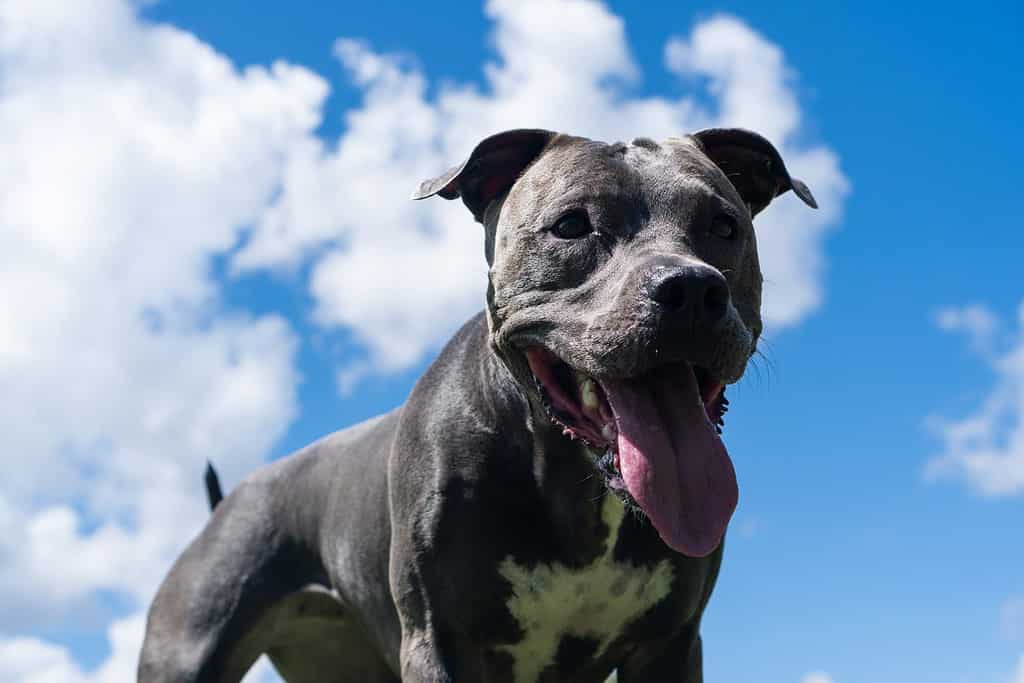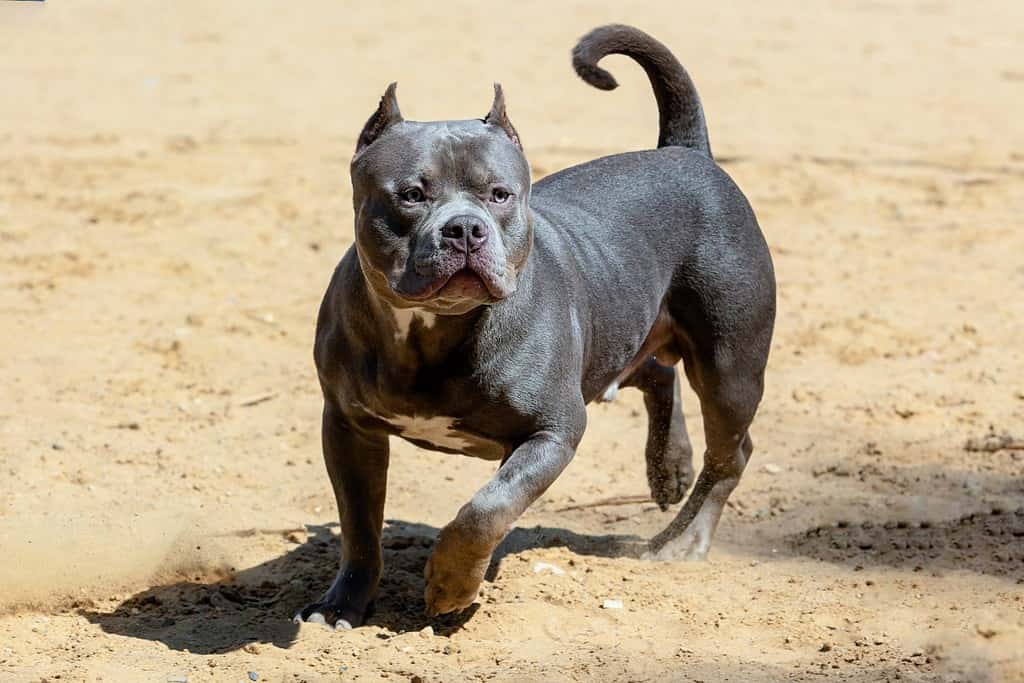Unique colorings of the Blue Bully exist, as do many other breeds of dogs. No other dog breed can compare to the unique Blue Bully breed. A point of conjecture amongst many is the official recognition of the Blue Bully as its own distinct dog breed, or just another coat color pattern. Some say it is just as another color variety of the American Bully with a Blue Nose gene. The American Bully breed only was recognized by the United Kennel Club on July 15, 2013.
Identifying a Bully
The Blue Bully may get mistaken as a Pit bull on a quick glance. It does have a definite genetic influence in color appearance of the skin and coat. Otherwise, there is a distinct difference between both the American Bully and a Pit Bull. On a second side-by-side glance you will notice a bully is more muscular and very broad, and often has a larger head and shorter legs, while a Pit bull is not as muscular and not as wide.

Notice the lack of wide hips of the Blue nose Pit bull playing in the park.
©Diego Thomazini/Shutterstock.com
In general, a Blue Bully is a powerful canine with a gentile nature. By appearance, it has a broad chest and muscular appearance. It may appear intimidating to some. A Blue Bully also has a strong square-shaped jaw, thick neck and short dense fur. This breed has a great temperament and is an all around winner who is very people oriented. Personality wise an owner will quickly fall in love with their charm and intelligence. There is an even greater difference when it comes to the unique variety of hues and patterns that sets a Blue Bully apart. There is currently a high demand for these unique coloring patterns and hues.

Notice the wide hip size of a Bully playing on the sand.
©Kanyshev Andrey/Shutterstock.com
Blue Nose Genes and Dilution
“Blue” Bully does not mean that the dog is the color blue. Coat color variations do occur with both several types of Pit bulls, and the now the Blue Bully as well due to the same recessive dilution gene which affects the pigmentation of their skin. The “d” gene is a short name for the Dilution gene. It affects the production of eumelanin, which is responsible for the black pigment in dogs. A Blue Bully has more color exaduration. There is a completely different set of coat coloring up close.
Blue Nose Genes and Breed Health
Breeders highlight possible long-term overall breed health issues with the added presence of the “d” gene. They argue that the genes linked to the blue coat color may also cause a higher risk of certain skin conditions. The altered gene presence weaken the breeds overall strength, and brings more health issues down the line. As the Blue Bully breed goes forward, so will overall genetic curiosity and popularity of the Blue Bully.
“Blue” Bully Colorations to Consider
The Blue Bully definitely has unique colorings. The Dilution gene combined with the Bully breed makes it stand out from the rest.
- Blue Nose Bully – A “blue” nose does not always have a visual presentation. Even though the recessive gene is present. It dilutes the color and specifically effect the nose. Depending on breed combinations nose colors will vary.
- Blue Fawn Bully – Colors present in a tuxedo fashion, with blue covering the majority of the back and white also present underneath. The exaduration of color is sandy creamy, tan or beige. The fawn color is reminiscent of sun, warmth and happiness.
- Blue Brindle Bully- This coloring is rare due to it possessing two different sets of recessive genes. The colored Blue Bully shows off a stunning stripe pattern. Both parents would need to pass on the recessive gene.
- Blue Merle Bully – This Bully has a unique coat and a specific gene causes mottled lighter patches of fur.
- Tri-Color Bully – The tri-color effect present includes white, tan and brown. The primary color can also be blue.
All in all, having any color variety of Blue Bully will result in a happy, intelligent, devoted and friendly family pet to cherish and love. Unfortunately, there are many instances of people taking umbridge on the Blue Bully’s gentle nature for nafarious purposes. You will not be disappointed with your new friend getting a Blue Bully!
The photo featured at the top of this post is © Zanna Pesnina/Shutterstock.com
Thank you for reading! Have some feedback for us? Contact the AZ Animals editorial team.






